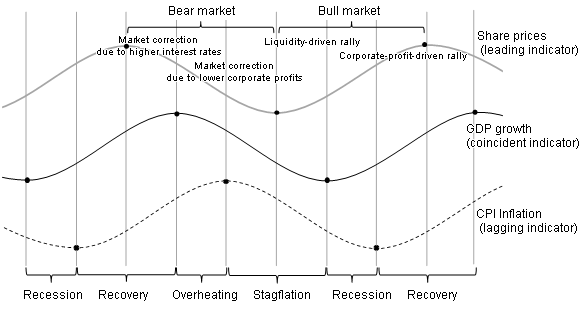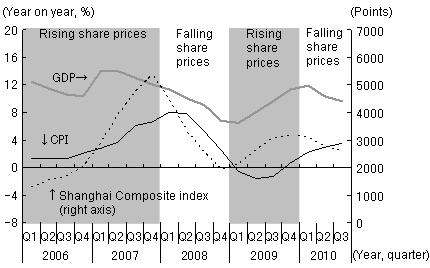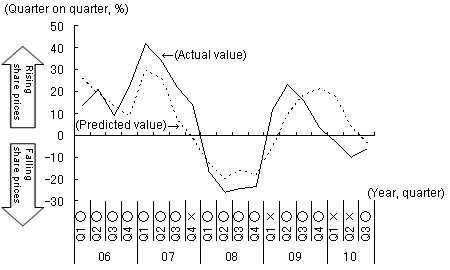In China, both the Shanghai Stock Exchange and Shenzhen Stock Exchange were established in 1990, but most listed company shares were owned by the government and could not be traded. Consequently, the stock market in China was unable to fulfill its primary functions of financing and investment, and had a strong speculative nature, leading to a long-term reputation in some quarters as a casino, where share prices movements did not reflect the economic fundamentals. However, with the reform of non-circulating shares that began in 2005 as a start, the government has been working to create a healthy stock market, and share prices today better reflect macroeconomic trends such as economic growth and inflation.
Relationship between the share price cycle and the business cycle
The economic cycle moves from low growth and low inflation (recession), to high growth and low inflation (recovery), high growth and high inflation (overheating), low growth and high inflation (stagflation), and then back to low growth and low inflation (recession) (Figure 1). This reflects the fact that inflation is a lagging indicator of economic growth. In addition, adopting a restrictive monetary policy to raise interest rates during the phase of overheating and adopting an easy monetary policy to lower interest rates in a recession helps to reinforce this business cycle.
| Figure 1: Business Cycle and Share Price Cycle in Terms of Growth and Inflation | |
 | |
| (Source) | Prepared by Chi Hung KWAN |
Meanwhile, share prices repeat the cycle of "a liquidity-driven rally, a corporate-profit-driven rally, a market correction prompted by expectations of or an actual increase in interest rates, and a market correction prompted by expectations of or an actual decrease in corporate profits and a liquidity-driven rally." First, the liquidity-driven rally, in which share prices rise following lower inflation and in turn falling interest rates, will be formed in an economic downturn, as shares that look more attractive will be viewed favorably as investment vehicles. Then, shares prices head for a corporate-profit-driven rally, the next stage of a bull market, where prices rise on the back of strong corporate earnings in association with the economic recovery. Subsequently, as inflation and interest rates rise, associated with monetary tightening, with the overheating economy as the backdrop, a series of bull markets from a liquidity-driven rally to a corporate-profit-driven rally will end. Share prices will go through a market correction in light of higher interest rates and a market correction caused by lower corporate profits before once again entering the phase of a liquidity-driven rally due to lower interest rates. As just described, share prices have a strong tendency to reach a turning point before the bottom and peak of the economy and can be regarded as a leading indicator of the economy.
Growth and inflation hold the key to changes in share prices in China
This relationship between the business cycle and the share price cycle has been observed in China since 2006. Share prices rose from the first quarter of 2006 to the fourth quarter of 2007 and from the first quarter to the fourth quarter of 2009, and fell from the first quarter to the fourth quarter of 2008 and from the first quarter to the third quarter of 2010. However, both of the two bull markets began with low inflation (a liquidity-driven rally) and ended following higher inflation (a market correction due to higher interest rates) through the high growth period (the corporate-profit-driven rally) (Figure 2).
| Figure 2: Changes in Share Prices, GDP Growth and CPI Inflation in China | |
 | |
| (Note) | Averages are from the first quarter of 2001 to the third quarter of 2010. |
| (Source) | CEIC Database |
Will the global economic boom come in 2012?
To confirm the relationship between share prices and the economy more rigorously, a regression analysis was conducted for data from the first quarter of 2006 to the third quarter of 2010 (a total of 19 quarters), with the Shanghai Composite Index (quarter on quarter) as the explained variable and GDP growth (year on year) and CPI inflation (year on year) as the explanatory variables. This analysis shows the following result: The Shanghai Composite Index will rise 6.8% if the growth increases 1%, and in contrast will fall 4.6% if the inflation rises 1% (by comparison, the effect of growth and inflation on share prices was not confirmed in a similar estimate for data from the first quarter of 2001 to the fourth quarter of 2005).
This formula predicts that share prices will rise in a total of 12 quarters from the first quarter of 2006 to the third quarter of 2007 and from the second quarter of 2009 to the second quarter of 2010 and fall in the remaining seven quarters (from the fourth quarter of 2007 to the first quarter of 2009 and in the third quarter of 2010). Among them, the direction predicted has proven correct in 15 quarters (of which share prices rose in 10 quarters and fell in five quarters), while it has proven incorrect in only four quarters (the fourth quarter of 2007, the first quarter of 2009, and the second and third quarters of 2010). As such, this formula is extremely adept at describing the trend (Figure 3).
| Figure 3: Changes in the Shanghai Composite Index (Quarterly) —Actual value vs. predicted value— | |
 | |
| (Note) |  O : The predicted value rises or falls with the actual value. X : The predicted value moves in the opposite direction from the actual value. |
| (Source) | Estimated and prepared based on CEIC Database |
The next bull market may come in the second half of 2011
Currently, China is approaching the stagflation phase of low growth and high inflation, after going through the overheating phase of high growth and high inflation. Speaking from a share price cycle perspective, China is at the stage of a market correction due to higher interest rates. The Chinese economy is expected to head into a recessionary period of low growth and low inflation in the second half of 2011 after going through the stagflation phase. At the same time, the share price cycle is also expected to enter the phase of a liquidity-driven rally, following a market correction caused by lower corporate profits.


